Lymphocytic Microparticles Modulate Angiogenic Properties of Macrophages in Laser-induced Choroidal Neovascularization
- PMID: 27874077
- PMCID: PMC5118818
- DOI: 10.1038/srep37391
Lymphocytic Microparticles Modulate Angiogenic Properties of Macrophages in Laser-induced Choroidal Neovascularization
Abstract
Pathological choroidal neovascularization (CNV) is the common cause of vision loss in patients with age-related macular degeneration (AMD). Macrophages possess potential angiogenic function in CNV. We have demonstrated that human T lymphocyte-derived microparticles (LMPs) exert a potent antiangiogenic effect in several pathological neovascularization models. In this study, we investigated the alteration of proangiogenic properties of macrophages by LMPs treatment in vitro and in vivo models. LMPs regulated the expression of several angiogenesis-related factors in macrophages and consequently stimulated their antiangiogenic effects evidenced by the suppression of the proliferation of human retinal endothelial cells in co-culture experiments. The involvement of CD36 receptor in LMPs uptake by macrophages was demonstrated by in vitro assays and by immunostaining of choroidal flat mounts. In addition, ex vivo experiments showed that CD36 mediates the antiangiogenic effect of LMPs in murine and human choroidal explants. Furthermore, intravitreal injection of LMPs in the mouse model of laser-induced CNV significantly suppressed CNV in CD36 dependent manner. The results of this study suggested an ability of LMPs to alter the gene expression pattern of angiogenesis-related factors in macrophages, which provide important information for a new therapeutic approach for efficiently interfering with both vascular and extravascular components of CNV.
Conflict of interest statement
The authors declare no competing financial interests.
Figures
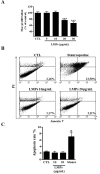
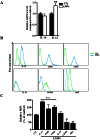
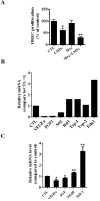
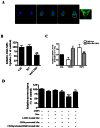
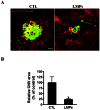

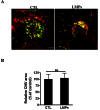
Similar articles
-
p75 neurotrophin receptor participates in the choroidal antiangiogenic and apoptotic effects of T-lymphocyte-derived microparticles.Invest Ophthalmol Vis Sci. 2013 Sep 9;54(9):6084-92. doi: 10.1167/iovs.13-11896. Invest Ophthalmol Vis Sci. 2013. PMID: 23920372
-
Lymphocytic microparticles suppress retinal angiogenesis via targeting Müller cells in the ischemic retinopathy mouse model.Exp Cell Res. 2021 Feb 15;399(2):112470. doi: 10.1016/j.yexcr.2021.112470. Epub 2021 Jan 9. Exp Cell Res. 2021. PMID: 33434529
-
microRNA-181a inhibits ocular neovascularization by interfering with vascular endothelial growth factor expression.Cardiovasc Ther. 2018 Jun;36(3):e12329. doi: 10.1111/1755-5922.12329. Epub 2018 Apr 24. Cardiovasc Ther. 2018. PMID: 29608244
-
Synthesis and Biomedical Potential of Azapeptide Modulators of the Cluster of Differentiation 36 Receptor (CD36).Biomedicines. 2020 Jul 23;8(8):241. doi: 10.3390/biomedicines8080241. Biomedicines. 2020. PMID: 32717955 Free PMC article. Review.
-
Angiogenesis, choroidal neovascularization, and the coagulation system.Retina. 2005 Jan;25(1):19-25. doi: 10.1097/00006982-200501000-00002. Retina. 2005. PMID: 15655436 Review. No abstract available.
Cited by
-
The role of microvesicles containing microRNAs in vascular endothelial dysfunction.J Cell Mol Med. 2019 Dec;23(12):7933-7945. doi: 10.1111/jcmm.14716. Epub 2019 Oct 1. J Cell Mol Med. 2019. PMID: 31576661 Free PMC article. Review.
-
Extracellular Vesicle-Mediated Immune Regulation of Tissue Remodeling and Angiogenesis After Myocardial Infarction.Front Immunol. 2018 Nov 29;9:2799. doi: 10.3389/fimmu.2018.02799. eCollection 2018. Front Immunol. 2018. PMID: 30555478 Free PMC article. Review.
-
Molecular Mechanisms Underpinning Microparticle-Mediated Cellular Injury in Cardiovascular Complications Associated with Diabetes.Oxid Med Cell Longev. 2019 Feb 19;2019:6475187. doi: 10.1155/2019/6475187. eCollection 2019. Oxid Med Cell Longev. 2019. PMID: 30915196 Free PMC article. Review.
-
The role of lymphocytes and phagocytes in age-related macular degeneration (AMD).Cell Mol Life Sci. 2020 Mar;77(5):781-788. doi: 10.1007/s00018-019-03419-4. Epub 2020 Jan 2. Cell Mol Life Sci. 2020. PMID: 31897541 Free PMC article. Review.
-
A new rat model of treatment-naive quiescent choroidal neovascularization induced by human VEGF165 overexpression.Biol Open. 2020 Jun 11;9(6):bio048736. doi: 10.1242/bio.048736. Biol Open. 2020. PMID: 32086250 Free PMC article.
References
Publication types
MeSH terms
Substances
Grants and funding
LinkOut - more resources
Full Text Sources
Other Literature Sources
Molecular Biology Databases

